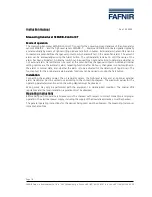
USER MANUAL
PTM 216B – BLUETOOTH
®
PUSHBUTTON TRANSMITTER MODULE
© 2022 EnOcean | www.enocean.com
F-710-017, V1.0
PTM 216B User Manual | v1.0 | February 2022 | Page 21/86
4.6.3
Commissioning telegram payload
The payload of commissioning telegrams is 30 bytes long and consists of the following
fields:
Length
(1
byte)
The Length field specifies the combined length of the following fields. For PTM 216B
commissioning telegrams, this field is set to
0x1D
to indicate 29 byte of manufactur-
er-specific
data.
Note: In product versions prior to DC-06 this field was incorrectly set to
0x1E
.
Type
(1
byte)
The Type field identifies the data type used for this telegram. This field is set to
0xFF
to
indicate
a
“Manufacturer-specific
Data”
field
Manufacturer
ID
(2
byte)
The Manufacturer ID field is used to identify the manufacturer of BLE devices based
on assigned numbers. By default, this field is set to
0x03DA
(EnOcean GmbH). This
field can be changed via the NFC configuration interface as described in chapter
6.7.7.
Sequence
Counter
(4
byte)
The Sequence Counter is a continuously incrementing counter used for security pro-
cessing. It is initialized to 0 at the time of production and incremented for each tele-
gram
(data
telegram
or
commissioning
telegram)
sent.
Security Key (16 byte)
Each PTM 216B device contains its own 16 byte device-unique random security key
which is generated and programmed during manufacturing. It is transmitted during
commissioning to enable the receiver to authenticate PTM 216B data telegrams and
used as IRK for the case of resolvable private address mode
Static
Source
Address
(6
byte)
The Static Source Address is used to uniquely identify each BLE device. It is trans-
mitted as part of the BLE frame as described in chapter 4.4.1.
Some devices (most notable all iOS-based products) however do not expose this
address to their applications. This makes it impossible to use such applications to
commission PTM 216B. The Static Source Address is therefore again transmitted as
part of the payload.
Figure 16 below illustrates the commissioning telegram payload.
Figure 16 – Commissioning telegram payload structure
















































